
Scutellaria montana, with the common names largeflower skullcap, large-flowered skullcap and mountain skullcap, is an perennial forb first described by Alvan Chapman in 1878. This narrowly endemic species is found in the southeastern United States in parts of the Ridge and Valley and Cumberland Plateau Physiographic Provinces. Populations have been documented from four Tennessee counties and nine Georgia counties and is protected under the US Endangered Species act as it is a threatened species. The Latin specific epithet montana refers to mountains or coming from mountains.
Scutellaria barbata, the barbed skullcap, is a species of flowering plant in the mint family, Lamiaceae. It is native to Asia.
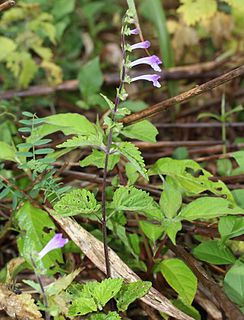
Scutellaria is a genus of flowering plants in the mint family, Lamiaceae. They are known commonly as skullcaps. The generic name is derived from the Latin scutella, meaning "a small dish, tray or platter", or "little dish", referring to the shape of the calyx. The common name alludes to the resemblance of the same structure to "miniature medieval helmets". The genus has a subcosmopolitan distribution, with species occurring nearly worldwide, mainly in temperate regions.

Scutellaria baicalensis, with the common name Baikal skullcap or Chinese skullcap, is a species of flowering plant in the family Lamiaceae.

Scutellaria lateriflora, known commonly as blue skullcap, mad dog skullcap, and side-flowering skullcap, is a hardy perennial herb of the mint family, Lamiaceae, native to North America.
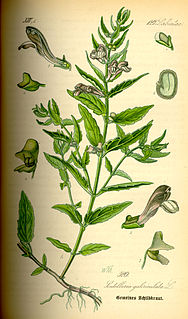
Scutellaria galericulata, the common skullcap, marsh skullcap or hooded skullcap, is a hardy perennial herb native to northern areas of the Northern Hemisphere, including Europe, Asia, and almost all of Canada. It is a member of the mint family. The form is upright and is usually 20 to 45 centimeters in height, sometimes reaching up to 80. It is a wetland-loving species and grows along fens and shorelines. The blue flowers are 1 to 2 centimeters long. The flowers are in pairs and are all on the same side of the stem. The flowers do not appear at the top of the stem.
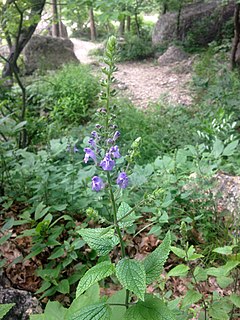
Scutellaria ovata, commonly known as the heartleaf skullcap, is a member of the mint family (Lamiaceae). Its range in the United States is from Minnesota to Florida, and from Texas to the Atlantic coast. It is also native to Mexico.

As baicalin is a flavone glycoside, it is a flavonoid. It is the glucuronide of baicalein.

Scutellaria nana is a species of flowering plant in the mint family known by the common names dwarf skullcap and dwarf scullcap. It is native to the western United States, especially in and around the Great Basin. It grows in plateau scrub, often on volcanic soils. It is a small perennial herb producing one or more erect stems up to about 20 centimeters tall from a rhizome. It is coated in tiny flat hairs which sometimes have resin glands. The leaves are oval or diamond-shaped, the lower ones borne on short petioles. Flowers occur in the leaf axils, each borne in a calyx of sepals with a prominent ridge on the upper surface. The corolla is up to 2 centimeters long, tubular in shape, and generally white or yellowish with purple mottling on the lips.

Baicalein (5,6,7-trihydroxyflavone) is a flavone, a type of flavonoid, originally isolated from the roots of Scutellaria baicalensis and Scutellaria lateriflora. It is also reported in Oroxylum indicum and Thyme. It is the aglycone of baicalin. Baicalein is one of the active ingredients of Sho-Saiko-To, a Chinese herbal supplement believed to enhance liver health.

Oroxylin A is an O-methylated flavone, a chemical compound that can be found in the medicinal plants Scutellaria baicalensis and Scutellaria lateriflora, and the Oroxylum indicum tree. It has demonstrated activity as a dopamine reuptake inhibitor, and is also a negative allosteric modulator of the benzodiazepine site of the GABAA receptor. Oroxylin A has been found to improve memory consolidation in mice by elevating brain-derived neurotrophic factor (BDNF) levels in the hippocampus.
Scutellaria siphocampyloides is a species of flowering plant in the mint family known by the common name grayleaf skullcap. It is endemic to California, where it is widespread throughout the mountain and coastal regions; it is absent from the deserts and the Central Valley. It can be found in forest and woodland habitat, and a variety of open habitat types. It is a perennial herb producing an erect stem or cluster of stems up to about half a meter tall from a system of thin rhizomes. The stems are coated in short, flattened hairs which sometimes have resin glands. The oval leaves are oppositely arranged. The lowest leaves are borne on short petioles. Flowers emerge from the leaf axils. Each flower is held in a calyx of sepals with a large ridge or appendage on the upper part. The tubular corolla can be up to 3.5 centimeters long and has a large upper and lower lip. The upper lip is folded into a beaklike protrusion and the lower has three wide lobes. The corolla is pale lavender to deep purple in color, sometimes with white mottling on the lower lip.
Caloptilia scutellariella is a moth of the family Gracillariidae. It is known from Ontario, Canada, and Ohio and Michigan in the United States.
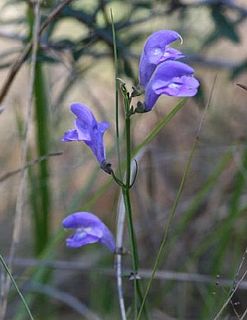
Scutellaria floridana, the Florida skullcap, is a rare species of flowering plant. It is endemic to Florida in the United States, where it is known only from the Florida Panhandle. It is threatened by a number of human activities and its small population sizes make it vulnerable. It is a federally listed threatened species.
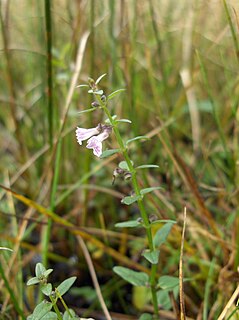
Scutellaria minor, the lesser skullcap, is a species of flowering plant in the family Lamiaceae.

Scutellaria parvula, commonly known as the small skullcap, is a member of the mint family. It is native to eastern and central North America, being most common in the central states and become rare in the east. It is found in areas that provide ample sunlight, such as prairies, glades, and savannas, often in calcareous soil. Flowering time is from late spring to early summer.

Scutellaria integrifolia, commonly called helmet flower or helmet skullcap, is a flowering plant in the mint family. It is native to the eastern United States where it is found in openings in mesic, acidic soil. It likely requires disturbance in the form of fire to maintain its appropriate habitat.

Anubias hastifolia is a species belonging to the Aroid genus Anubias. It was first mentioned by Adolf Engler in 1889 and described scientifically by him in 1893.
Scutellaria glabriuscula, commonly known as Georgia skullcap, is a flowering plant. It is a perennial dicot in the family Lamiaceae, and is part of the genus Scutellaria. It grows in the Florida panhandle and parts of Georgia, Mississippi, and Alabama.














